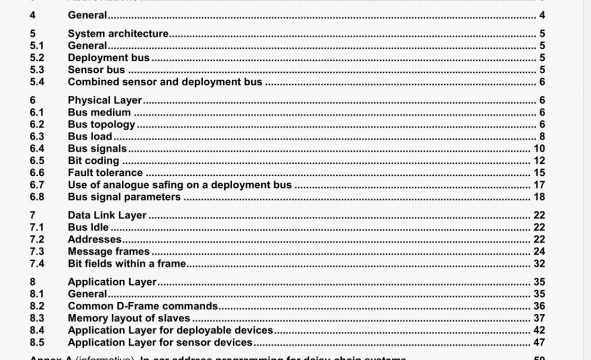ISO 22896 pdf download – Road vehicles一Deployment and sensor bus for occupant safety systems.
A dynamic sensor slave shall have the additional option to pull an LU- or Li-level down to the LSO-level. which means either that the slave can submit an interrupt to the master or that it can Indicate a detected error during transmission (see 7.4.9 and 8.5.4).
The master shall use either the 10-level or the ISO-level for the representation of a 0, depending whether the message is a normal message or a qualified one (analogue safing]. See also 6.7.
The P-level shall be about 12 V for normal operation, orit may be raised up to 30 V for special purposes such as OTP programming lithe slaves, Raising the P-level shall not be considered applicable in the system, but for off-line use only. Slaves not requiring an increased P-level for certain functions need not tolerate such a level. All slaves shall tolerate and shall not be damaged by a differential bus voltage up to 20 V. This takes into account failure modes In the a.rbag ECU that may lead to a temporarily wicreased bus level.
10 can be overwritten by Li or by ISO: Li can be overwritten by ISO. The P-level cannot be overwritten by any other level The exact bus levels are specified in 6.8.
NOTE Higher voltage at same slew rate level implies lower speed
6.5 Bit coding
6.5.1 G.n.ral
The time during which the master transmits the power level is called the Power Phase. The time during which the master transmits a data level is called the Data Phase The master shall transmit a steady sequence & Power and Data Phases. During one Data Phase, one bit shall be transmitted (see Figure 5), The slaves shall extract power from the bus during the Power Phase only. The average duty cycle for the Power Phase should be about 50%.
Speed changes for high-speed deployment messages can be initiated by the master For high-speed sensor polling messages, speed changes can be initiated by a sensor with interrupt cability.
Speed changes shall go into effect with the beginning & a new Power Phase (for details and restrictions, see 6.5.2).
When the master does not transmit a message (= Bus Idle) or when the master transmits a frame in which It expects a slave to transmit data, the master shall transmit the 10-level during Data Phases. The 10-level can be overwritten by another data level from a slave, when the slave is transmitting data. In order to transmit the bit value ‘0”. the slave shall leave the Data Phase as is. In order to transmit the bit value 1, the slave shall pull the bus voltage down to 11-level. On a deploy bus during D-Frames, the master shall read the slave’s transmit current instead of checking the bus voltage. Therefore, it is not necessary that the slave actualy pull the bus voltage completely down to Il-level. In order to send an interrupt or to indicate an error during S-Frames, the slave shall pull the bus voltage down to ISO-level (applicable to dynamic sensors only).
NOTE Data bits are surrounded by power distrtutlon level phases. The level ‘ISO’ Is used esther for analogue satIng of deploy messages. or for signalling an Interrupt or error condition from a dynamic sensor to the master
6.5.2 Start of frame (SOF)
The Physical Layer shall provide a special SOF symbol, which is characterized by a temporary doubling of the duration of the Power Phase (P) and of the fllowing Data Phase (0) of one bit (see Figure 6).
The bit level within the SOF shall indicate the type (T”, see 7.4.2) of the subsequent frame.
The master shall start a new frame by sending the SOF symbol. Usually, this is done after completion of a previous frame or during Bus ldle. The master can also send a new SOF during a frame. This shall terminate the running frame and shall start a new one. For this case, the fllowing rules apply.
The master shall not send an SOF immediately after an SOF, there shall be at least one data bit in between.
一When the current frame is a D-Frame requesting data and the new frame is also a D-Frame (7.3.2), the master shall send the SOF twice, with at least one idle bit in between (see also Annex C ). When the new frame is a deploy command with safing, the idle bit(s) between the dual SOF shall be transmitted with safing level as well (LS0).
ISO 22896 pdf download – Road vehicles一Deployment and sensor bus for occupant safety systems
